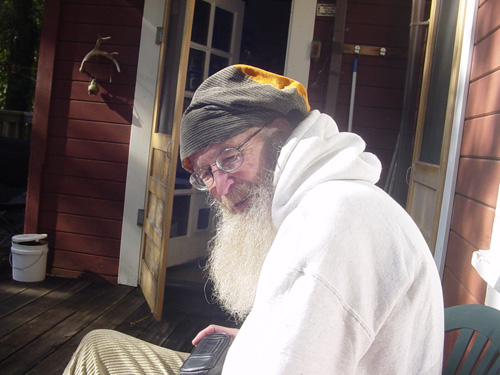I’ve been busy working on my novel Hylozoic. I finally got into Chapter Seven, my second chapter set in Bosch’s home town. (Part of the first chapter set in Bosch’s town was in Flurb #4). It’s bawdy and medieval and funny and I’m happy to be writing and polishing my words. But I’m not having much time to blog.

[A 200 pound yam on Ponhpei in Micronesia: objective correlative for my Chapter Seven.]
Sooo, for today, here’s a nine-step argument that everything is conscious (panpsychism) and that everything is alive (hylozoism). While getting ready for Chapter 7 I wrote up this argument for my paper for the published proceedings of the “What is Life?” conference I went to in Kyoto in Fall, 2007. You can see a PDF of a draft of the full paper online, or just examine the bare-bones outline of the argument here.

[Nick Herbert at his house last week, wearing his “indescribable hat.”]
(1) Universal Automatism. Every physical entity is a computation. (See The Lifebox, the Seashell, and the Soul, scroll to Chapter 1 on p. 4).
(2) Moreover, every physical entity is a gnarly computation. (See my YouTube “What is Gnarl” video, below.)
(3) Wolfram’s Principle of Computational Equivalence. Every naturally occurring gnarly computation is a universal computation. (See A New Kind of Science, p. 715.)
(4) Consciousness = Universal Computation + Self-Reflection.

[Nick’s outdoor bathtub.]
(5) Any complex system can be regarded as having self-reflection.
(6) Panpsychism. Therefore every physical entity is conscious.

(7) Walker’s Thesis. Life = Universal Computation + Memory. (See Walker’s online paper.)
(8) Every physical entity has memory via its interactions with the universe.

(9) Hylozoism. Therefore every physical object is alive.
Q.E.D.

[Professor Rucker demonstrates the “rolling buffalo” yoga asana at Nick’s.]









January 23rd, 2008 at 6:21 am
There you go! Something to be remembered for.
I think it takes only one observation to get to pantheism. Namely, that all things are entangled at the quantum level and that at the macro level the separation of objects is an illusion. Therefore there is only one consciousness and it is the universal consciousness.
In the beginning God noticed, “I am not.”
January 23rd, 2008 at 12:33 pm
Rudy – Interesting ideas …. which fit nicely with some of Godel’s ideas about consciousness that are discussed by Hao Wang in his book ” A Logical Journey: From Godel to Philospphy.”
I’m also curious how you would reconcile time(especially Godel’s concept of time) with your theory.
February 15th, 2008 at 4:28 pm
It seems to me you have only succeeded in rendering two words useless: “conscious” and “alive.” These are supposed to make useful distinctions between ourselves and rocks. Does a synthesis erase the difference between the thesis and its opposite? Application of the concept of “computation” to everything might well paint the universe with a vestige of our consciousness, so we see ourselves everywhere and call the universe conscious. A computation is usually considered a manipulation of abstractions, otherwise the operation of a computer is meaningless. The initial smearing of this word is a problem, in my view.
February 15th, 2008 at 4:40 pm
Russell, I’m not seriously urging that we abandon forever our (vague) received notions of what conscious and alive mean.
My point here is to open up the reader’s sense of what’s possible. Of course it’s useful to distinguish oneself from a rock. But it’s also useful—but much less often attempted—to argue the distinction away.
My thoughts on computation are too complicated to fit into this margin! But you might check the first chapter of my Lifebox tome if you’re curious about what I really have in mind. The first half of the book is online under the “Book Sample” button on the book’s home page.
February 16th, 2008 at 1:27 am
i think that “As It Should Be” is a deep program or truth or whatever.
and so, the rock is as it should be, look it has my name in the side,
look, it looks like rudy. i set the rock down.
how can THIS four-words into the future be better used?
As It Should Be. and so one wonders, what should the future be like?
and so it is, continually!
February 17th, 2008 at 5:50 pm
An emotional parry to this ‘enlightenment’: delicious sinking. Rogier Caillois’s 1935 dense and rewarding writing in Minotaure on the consciousness of a moth whose wings imitate the rock it rests on:
“alongside the instinct of self-preservation, which in some way orients the creature toward life, there is generally speaking a sort of instinct of renunciation that orients it toward a mode of reduced existence, which in the end would no longer know either consciousness or feeling–the inertia of the élan vital, so to speak. It is on this level that it can be gratifying to give a common root to phenomena of mimicry both biological and magical and to psychasthenic experience, since the facts seem so well to impose one on them: this attraction by space, as elementary and mechanical as are tropisms, and by the effect of which life seems to lose ground, blurring in its retreat the frontier between the organism and the milieu and expanding to the same degree the limits within which, according to Pythagoras, we are allowed to know, as we should, that nature is everywhere the same”-
February 24th, 2008 at 11:26 am
I apologize for only having read a few pages of your Lifebox book, but I will irresponsibly put forth a couple of critical ideas nevertheless, and then read some more. A refutation of your proof might proceed as follows:
Every thing that exists is a computation, by some appropriate definition of computation.
Collapsing steps 2 and 3 (since I have not read down to where you explain “gnarly”), every computation by some physical entity is universal.
Now, my understanding of a universal computation is that it must have many states, like a Turing machine with a long tape. A hydrogen atom exists, so what can it do? Can a hydrogen atom represent a xenon atom? It cannot, since the xenon atom has excited states of the nucleus that could make it break into smaller pieces. Thus the hydrogen atom, with too few states, is not a universal computation.
I got to your work through reading Douglas Hofstadter, who argues that consciousness requires a highly complex computing system, which is capable of abstraction (my words). I agree with him. It’s the lack of complexity that makes simple things like quantum systems incapable of such feats.
In general, I’m trying to argue against some other people as well, who ascribe consciousness to atoms in order to collapse quantum wave functions in neurons and yet claim the wave function collapses at consciousness also.
February 24th, 2008 at 8:09 pm
So, having read most of the sample, I’m still not clear on some of the steps. First, are you saying that even a little atom partakes of enough universal entanglement so that its response is complex, that is, unpredictable? Lee Smolin (The Trouble with Physics) suggested this as an explanation for quantum randomness. But, if true, this sort of complexity is a mess. It hasn’t the structure required to implement consciousness as we understand the term, like a giant computer with no software. This is why computers won’t become spontaneously intelligent once they get past a certain number of logic gates/neurons. All one hears is the hiss of white noise, fourth class if I remember your categories. So, even if the possible “states” of an atom include the particular times at which it emits a photon, intelligibility is probably not in the cards, or dice as Einstein would have it.
March 29th, 2008 at 10:10 pm
I was quite taken up by your use of dialectics here since I am myself a Marxist. I have something more to say about this later on (my website is still in preparaion). However, I must point out some disparaging remarks about Hegel made by George Simmons in his book “Differential Equations with Applications and Hisorical Notes,” McGraw-Hill, 1972. He states in Chapter 5, Appendix C (p.199) that “The first and largest of the numerous minor planets known as asteroids was discovered in that region [predicted by Bode’s law] in 1802, and was named Ceres. This discovery ironically coincided with an astonishing publication by the philosopher Hegel, who jeered at astronomers for ignoring philosophy: this science (he said) could have saved them from wasting their efforts by demonstrating that no new planet could possibly exist. Hegel continued his career in a similar vein, and later rose to even greater heights of clumsy obfuscation.”
Later on in the book, he says about Laplace: “At the age of twenty-four he was already deeply engaged in the detailed application of Newon’s law of gravitation to the solar system as a whole, in which the planets and heir satellites are not governed by the sun alone but interact with each other in a bewildering variety of ways. Even Newton had been of the opinion that divine intervention would occasionally be needed to prevent this complex mechanism from degenerating into chaos. Laplace decided to seek reassurance elsewhere, and succeeded in proving that the ideal solar system of mathematics is a stable dynamical system that will endure unchanged for all time.” (Chapter10, Appendix A.) Whatever Laplace and subsequent workers on differential equations may have established, deterministic physics is bound to break down where inelastic collisions of solar system objects and phase transitions take place. This is probably what Newton had in mind which Simmons has overlooked. Solar system physics seems to be an area in which a lot of gnarly computations could be involved. It is not unreasonable to invoke the hypothesis of pantheism in this connection.
George Simmons’ book is far too useful an introduction to differential equations to ever be ignored, but may leave the inexperienced beginning reader with the wrong preconceived notions.
December 31st, 2008 at 4:53 pm
I am a marathon swimmer and many times in this ordeal I “feel” the water. When my spouse died I dreamt her words, “The water will speak to you”. (We were pretty close!) So, anyway as a reasonable research scientist, I have pursued the idea of panpsychism. My thermodynamic background suggests that descriptions that are “external” can apply to internal “goings on”. Everything requires two processes, namely, motion and growth while “life” requires reproduction. Clearly, light velocity has captured the ultimate motion while mass seems to have captured growth. Now light needs mass for its validation. What does mass need? Simply time. Check my ideas on Scribd, linked on my web site.